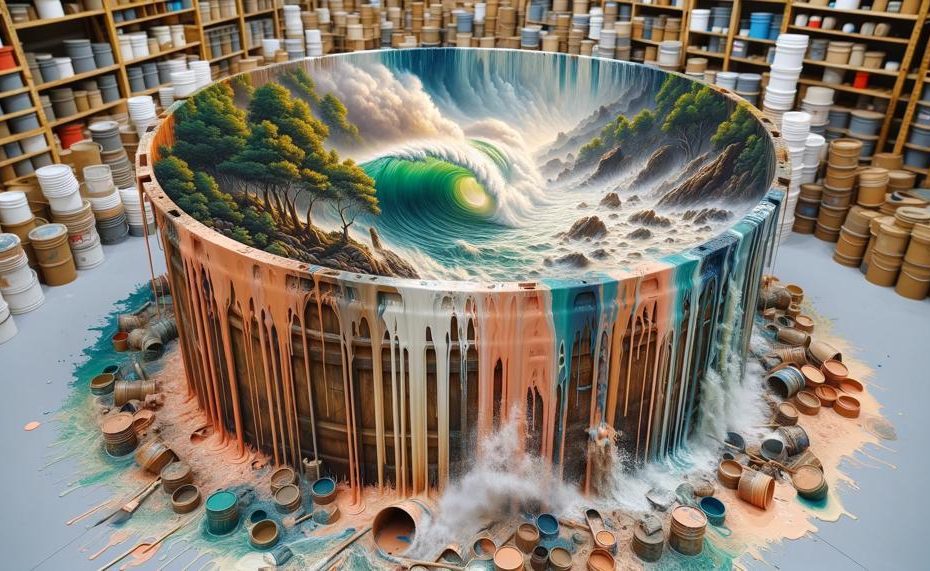Are you staring at a murky jar of paint water and wondering about the secret to making it disappear responsibly? You’re not alone. As art enthusiasts and DIY decorators, we often find ourselves in a colorful conundrum: how to dispose of paint-laden water without harming Mother Nature?
In today’s eco-conscious world, it’s crucial to find ways to minimize our environmental footprint – and that includes the seemingly mundane task of cleaning up after a painting project. This blog post will guide you through the greenest strategies for handling paint water disposal, ensuring that your artistic flair doesn’t come with an environmental cost.
From innovative DIY filtration systems to community-based disposal programs, we’ll dive into a palette of options that are both practical and environmentally sound. Our goal is to arm you with knowledge so that your next project is as clean as it is creative.
So, how to dispose of paint water properly?
Here are some ways to dispose of paint water:
- Use a bucket: Let the water evaporate and the paint solids settle at the bottom of a bucket. Then, carefully pour off the clear water and wipe out the remaining pigment. You can throw away the dried paint in a trash bag with your other trash.
- Use cat litter: Put 6–8 inches of clumping cat litter in a 5-gallon bucket, then pour in your paint water. Once it clumps, remove all the clumps and dispose of it in the trash.
- Use a three bucket system: Use progressively cleaner water in three buckets.
- Send it to a toxic waste site: Pour the dirty water in a large bucket, let the pigment settle out, and then send it to a toxic waste site.
You can rinse brushes and painting equipment in a sink or basin that can capture the rinse water. Sanitary sewer systems can digest rinse water into harmless products. However, do not pour undiluted paint into a sink or toilet.
So, roll up your sleeves and prepare to give your used paint water an eco-friendly send-off that would make even the most discerning environmentalists proud.
Contents
- 1 Proper Disposal Methods
- 2 Safe Handling and Storage
- 3 Environmentally Friendly Disposal Alternatives
- 4 Disposal Options
- 5 Safe Disposal of Paint Water
- 6 Evaporating Paint Water
- 7 Filtering and Reusing Paint Water
- 8 Storing and Disposing of Solidified Paint Residue
- 9 Utilizing Paint Water in Art Projects
- 10 Donating or Recycling Leftover Paint Water
- 11 Conclusion
Proper Disposal Methods
| Method | Materials Needed | Steps |
| Coffee Filter | Coffee filter, container | Filter water through the coffee filter into the container multiple times. |
| Evaporation | Wide, shallow container, sunlight | Spread paint water in the container; leave in sun for evaporation. |
| Drain Screen | Drain screen with fine mesh | Install in sink; clean regularly to catch paint particles. |
| Kitty Litter | Clumping kitty litter, bucket | Mix paint water with kitty litter; dispose of solidified clumps. |
Remember, chaps, proper disposal of paint water isn’t just kind to your pipes; it’s a nod to Mother Earth.
Safe Handling and Storage
Handling and storing paint water with the right approach is key to ensuring its safe disposal. Here’s how to tackle it:
Wear Protective Gear
Always suit up with gloves and goggles when dealing with paint water to protect your skin and eyes from irritation.
Label Containers Clearly
Mislabelled containers are a recipe for disaster. Make sure all containers are marked with their contents and hazard warnings.
Cool, Dry Storage
Keep your paint water in a spot that’s both cool and dry, steering clear of places where kids and pets might stumble upon them.
Evaporation Method
Let’s put that excess paint water in a non-porous dish and give it some air. A well-ventilated spot will help the liquid evaporate, leaving you with less to dispose of.
Filter and Reuse
If the paint water’s not too mucky, run it through a filter. You might just be able to give it a second life for cleaning brushes.
Solidify and Secure
For the gunk left behind, let it turn solid. Then, pop it in a secure container and follow your local waste disposal rules to the letter.
Creative Reuse
Feeling artsy? Paint water can add a splash of colour to a new project. Otherwise, pass it on to local art communities who could use it.
Stay Informed
Keep up with the local regulations on acrylic paint water disposal. It’s your map to doing things by the book.
Eco-Friendly Options
Go green with your paint choices. Look for paints with an eco-friendly badge and consider composting organic residues.
Recycle and Donate
Some places have recycling programs specifically for paint products. Or, you could donate clean paint water to local art schools or artists.
Environmentally Friendly Disposal Alternatives
Disposing of paint water without harming the environment requires a touch of creativity and a commitment to sustainability. Here are some eco-conscious methods:
| Method | Description | Consideration |
| Evaporation | Allow water to evaporate leaving pigment to dispose of as solid waste. | Ensure safe area for evaporation where no animals/pets can access. |
| Recycling/Reuse | Clean and reuse water for other painting projects. | May not be suitable for all paint types. |
| Solidification | Mix with absorbent material to solidify before disposal. | Choose a biodegradable absorbent to enhance eco-friendliness. |
| Artistic Use | Repurpose in creating artistic effects. | Encourages creativity and reduces waste. |
| Community Contribution | Donate to local art programs. | Supports local art community and promotes reuse. |
| Recycling Programs | Hand over to specialized recycling centers. | Contributes to circular economy practices. |
| Eco-conscious Paints | Choose paints that are less harmful to the environment. | Preventative approach to reduce future waste. |
| Composting | Compost organic paint residues. | Only suitable for certain types of paints and pigments. |
| Regulatory Compliance | Follow local guidelines for disposal. | Essential to prevent legal issues and environmental harm. |
| Professional Disposal | Seek advice from waste management services. | Ensures proper disposal especially for large quantities. |
These alternatives not only keep our planet greener but also inspire us to think outside the box when it comes to what we consider ‘waste’.
Disposal Options
Disposing of paint water in an environmentally conscious manner is crucial for preserving our plumbing systems and protecting our planet’s ecosystems.
Below are methods to discard paint water that won’t leave a blemish on Mother Nature.
Filter and Reuse
| Method | Procedure | Considerations |
| Coffee Filter | Strain the paint water through a coffee filter to catch solids. | Inexpensive and easily available, but may require several filters for larger volumes. |
Natural Evaporation
| Method | Procedure | Considerations |
| Evaporation Technique | Leave the water in an open container to evaporate in a well-ventilated area. | Best for water-based paints; time-consuming and requires a safe spot away from animals and children. |
Physical Barriers
| Method | Procedure | Considerations |
| Drain Screen | Place a screen over the drain to trap solids when washing brushes. | Simple to install but requires regular cleaning to remain effective. |
Absorption Method

| Method | Procedure | Considerations |
| Kitty Litter | Mix paint water with kitty litter to solidify, then discard. | Works well for small quantities but can be costlier for larger volumes. |
These options provide a palette of solutions to keep our environment untainted. Remember, always check local guidelines before disposing of paint-related waste. By sticking to these methods, creatives can ensure their art doesn’t leave a lasting mark on the environment.
Safe Disposal of Paint Water
Improper disposal of paint water can lead to significant environmental hazards. To understand the risks and how to mitigate them, consider the following information:
- Water Contamination: Paint-laden water that seeps into the ground can contaminate local water tables.
- Harm to Aquatic Life: Toxic substances in paint can increase water turbidity, suffocating aquatic organisms.
- Food Chain Disruption: Solvent-based paints contain chemicals that may cause tumors and other health issues in fish, affecting the entire food chain.
Avoiding the Risks
| Practice | Benefits | Instructions |
| Minimize Water Use | Less contaminated water to dispose of. | Use minimal water or thinner when cleaning tools. |
| Reuse Cleaning Water | Reduces the volume of waste. | Reuse the same water for cleaning multiple tools. |
| Proper Disposal | Prevents environmental contamination. | Dispose of leftover paint and water at designated drop-offs. |
To address these issues, follow these guidelines:
- Minimize Water Use: Keep the use of water or solvent to the bare minimum necessary for cleaning your tools. It’s better for the environment and your wallet.
- Reuse and Recycle: If you’ve got to clean, why not do it smart? Reuse the same bucket of water to wash out multiple brushes and rollers. When the water gets too murky, wait for the paint to settle, then decant the clear water and only dispose of the sludge.
- Solid Waste Management: Got leftover paint? Don’t just chuck it. Check if your local paint retailer takes it back or see if there’s a community project that could use it. You’d be surprised who can make use of your old colours.
- Education and Awareness: Spread the word, not the paint. Share these tips with fellow painters and encourage eco-friendly practices.
By implementing these practices, we can greatly reduce the environmental impact of paint water disposal.
Evaporating Paint Water
When the brush sways and the hue dances, painters often find themselves with a surplus of paint-kissed water. The question of disposal isn’t merely practical—it’s a stewardship of our Earth. Let’s explore how to vanish this liquid responsibly.
| Tip | Method | Benefit |
| Evaporation | Non-porous container, well-ventilated area | No residue to local environment |
| Reuse | Filter, store, label | Resource efficiency, artistic innovation |
| Recycle | Engage with community programs | Supports local environmental efforts |
Filtering and Reusing Paint Water
Filtering and reusing paint water is not just a savvy move for the frugal artist; it’s a stride towards environmental stewardship. Let’s break it down:
Filter the Flotsam:
Solid pigments and particles are the culprits that turn crystal clear water into a murky mess.
These particles can wreak havoc on our waterways, increasing turbidity and harming aquatic critters. By filtering out these solids, you’re removing the immediate danger to our fishy friends.
Reuse with Reason:
After you’ve caught those pesky pigment particles, the water’s not done working yet. It’s ripe for a second act, cleaning more brushes or even diluting colours for your next masterpiece. It’s a bit like giving water a second career, reducing the demand for fresh water and the volume of wastewater.
Drop the Disposal Drama:
With filtered and reused paint water, the amount you need to dispose of drops dramatically. You’re sparing the environment from the pollutants that paint water can carry.
Plus, you’re easing the load on sewage treatment plants that would otherwise have to work overtime to clean up our artistic aftermath.
Table of Techniques:
Here’s a table illustrating the steps and benefits of filtering and reusing paint water:
| Step | Action | Benefit |
| Catch the Culprits | Use a filter to trap solid particles in the paint water. | Prevents harm to waterways and aquatic life. |
| Second Serving | Reuse the filtered water for further brush cleaning or painting. | Conserves fresh water and reduces wastewater volume. |
| Ditch Disposal Woes | Minimize the need for disposal by reducing paint water waste. | Eases strain on sewage systems and the environment. |
By filtering and reusing, we’re not just saving a few quid on the water bill; we’re doing our part for the planet.
Storing and Disposing of Solidified Paint Residue
To ensure the safe storage and disposal of solidified paint residue, thereby reducing environmental impact, consider the following guidelines:
Storing Solidified Paint Residue
- Dry Completely: Allow the paint residue to dry out fully. This typically means leaving it in a well-ventilated area away from children and pets.
- Containment: Once dry, encase the residue in newspaper or a sealable plastic bag. This prevents any loose particles from escaping.
- Label and Secure: Store the wrapped residue in a robust container with a clear label detailing its contents. Secure the lid to prevent any accidental spillage.
- Accessibility: Keep the container in a location that is both out of reach of children and pets, and easily accessible to adults for proper disposal.
Disposing of Solidified Paint Residue
- Local Guidelines: Dispose of the solidified residue as per your local waste management regulations. These rules are designed to minimize environmental harm.
- Hazardous Waste Facilities: For paints that contain hazardous materials, consult with a local hazardous waste facility for disposal instructions.
- Avoid Water Systems: Never discard paint residue into drains or natural water bodies, as this can be detrimental to ecosystems.
- Composting: If the paint is organic and non-toxic, composting could be an option, but this is quite rare for most paint types.
- Expert Advice: When in doubt, seek out the advice of your local waste management services. They can offer the most current and relevant disposal methods.
Utilizing Paint Water in Art Projects
Paint water overflow is a common problem for makers and artists and may be considered a nuisance. Still, there’s a chance to explore this residual liquid artistically.
Here, we explore several creative ways to use paint water in the arts while encouraging creativity and making a positive impact on sustainability.
Creative Techniques for Paint Water Utilization
| Technique | Materials | Application |
| Colour Wash Backgrounds | Tinted Paint Water | Canvas Backgrounds |
| Mixed Media Textures | Paint Water, Baking Soda/Cornstarch | Texture Creation |
| Fabric Dyeing | Tinted Paint Water | Textile Art |
| Handmade Paper | Paint Water, Pulp | Coloured Paper Making |
| Ice Pigments | Frozen Paint Water | Dynamic Painting |
In a world where each action shapes the future, artists are the vanguard, transforming what might be seen as waste into wondrous works of art. By adopting these methods, we don’t just paint a picture; we paint a better world.
Remember, there’s no such thing as ‘just’ a drop in the ocean. Every drop counts. So, next time you’re left with murky waters at the end of a painting session, think twice before you toss it.
Donating or Recycling Leftover Paint Water
When it comes to dealing with leftover paint water, it’s a savvy move to be eco-conscious. Disposal options that are kind to our planet include the following:
Donate or Recycle:
| Charity and Community Groups | Seek out local groups like theatres, schools, or community centres, which might be chuffed to use your leftover paint for projects. |
| Recycling Centres | Check if your local recycling centre accepts leftover paint or paint water for recycling processes. |
| Exchange Programmes | Look for paint exchange events in your community where you can pass your leftovers to others who need it. |
Creative Reuse:
| Repurpose for Art | Get crafty by using the diluted paint for artistic endeavours like watercolour effects or dying textiles. |
| DIY Projects | Mix different paint water residues to discover new shades for small touch-ups or decorative items. |
Conclusion
In conclusion, properly disposing of paint water is a responsible thing to do as well as a way to show consideration for the environment. We now know a number of environmentally friendly ways to make sure that our creative endeavors don’t harm the environment thanks to this article. We’ve looked at easy do-it-yourself methods like evaporating coffee grounds in the sun and using drain screens and cat litter to solidify liquids. The most important lesson is that we can avoid any damage to our landfills and water systems with a little imagination and hard work.
Labeling containers, using safety clothing, and following municipal disposal laws are essential. Adopting sustainable procedures including hardening leftovers, recycling filtered paint water, and evaporating reduces waste. By converting possible trash into resources for others, artistic reuse and community involvement exemplify the ethos of eco-consciousness.
Furthermore, we may create a more ecologically friendly future by using eco-friendly paints, taking part in recycling initiatives, and being aware about correct disposal techniques. Recall that each well managed paint drop contributes to the preservation of our world. Your decisions matter, regardless of your level of experience as an artist.





